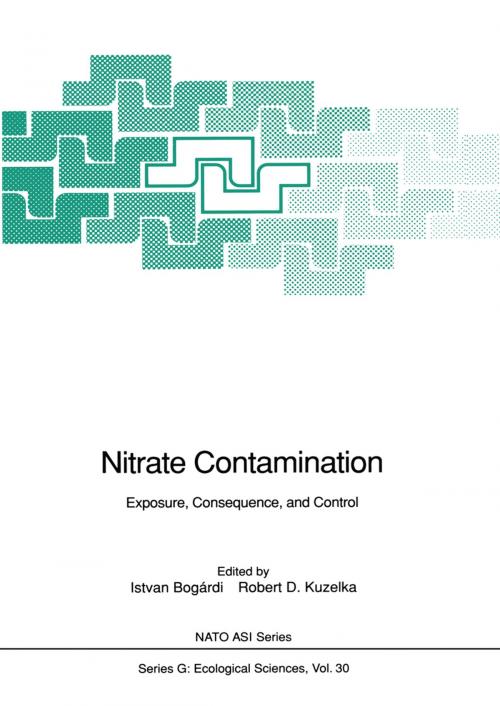Nitrate Contamination
Exposure, Consequence, and Control
Nonfiction, Science & Nature, Technology, Environmental, Science, Biological Sciences, Environmental Science| Author: | ISBN: | 9783642760402 | |
| Publisher: | Springer Berlin Heidelberg | Publication: | June 29, 2013 |
| Imprint: | Springer | Language: | English |
| Author: | |
| ISBN: | 9783642760402 |
| Publisher: | Springer Berlin Heidelberg |
| Publication: | June 29, 2013 |
| Imprint: | Springer |
| Language: | English |
The nitrate content of drinking water is rising at an alarming rate in several regions of NATO countries and elsewhere in the world. The increase is due to lack of proper sewage treatment, and primarily to excess fertilizer application. Also, eutrophication in several coastal areas is triggered by high nitrate concentrations. The main purpose of this book is to integrate scientific knowledge related to exposure assessment, health consequences and control of nitrate contamination in water. The motivation is related to the magnitude, the possible adverse health effects, and the high cost of control ling nitrate contamination. Future research tasks are defined by an interaction among hydro logists, toxicologists and environmental engineers in an integrated framework for nitrate risk management. The target readership of this book is a mix of university colleagues, practitioners from both the private and public sectors and advanced graduate students working with the hydrological, health science or environmental engineering aspects of nitrate contamination. The main conclusions include: 1. For risk assessment purposes, knowledge and sufficiently accurate models are available to predict nitrate load and its fate in water under changes in land use. 2. Once agricultural exposure controls are implemented, the response times in ground water may be so long as to make controls unrealistic. 3. It is still unknown whether agricultural best management practice is a compromise between nitrate risk reduction and agricultural revenue. 4. The current drinking water guidelines of 10 mg/L NOrN need not be changed.
The nitrate content of drinking water is rising at an alarming rate in several regions of NATO countries and elsewhere in the world. The increase is due to lack of proper sewage treatment, and primarily to excess fertilizer application. Also, eutrophication in several coastal areas is triggered by high nitrate concentrations. The main purpose of this book is to integrate scientific knowledge related to exposure assessment, health consequences and control of nitrate contamination in water. The motivation is related to the magnitude, the possible adverse health effects, and the high cost of control ling nitrate contamination. Future research tasks are defined by an interaction among hydro logists, toxicologists and environmental engineers in an integrated framework for nitrate risk management. The target readership of this book is a mix of university colleagues, practitioners from both the private and public sectors and advanced graduate students working with the hydrological, health science or environmental engineering aspects of nitrate contamination. The main conclusions include: 1. For risk assessment purposes, knowledge and sufficiently accurate models are available to predict nitrate load and its fate in water under changes in land use. 2. Once agricultural exposure controls are implemented, the response times in ground water may be so long as to make controls unrealistic. 3. It is still unknown whether agricultural best management practice is a compromise between nitrate risk reduction and agricultural revenue. 4. The current drinking water guidelines of 10 mg/L NOrN need not be changed.















